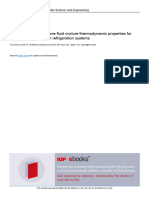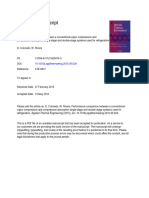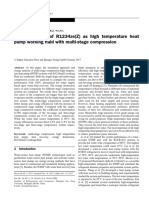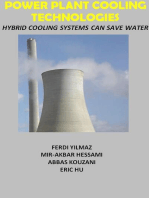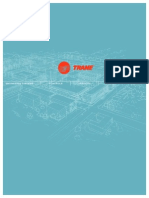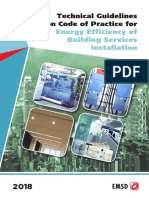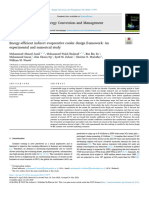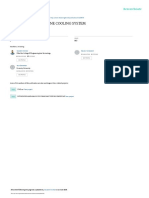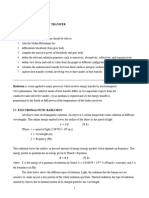Cops of R718 in Comparision With Other Modern Refrigerants: Al. (2) Have Presented The Applications Based On
Cops of R718 in Comparision With Other Modern Refrigerants: Al. (2) Have Presented The Applications Based On
Uploaded by
Carlos A. ChaconCopyright:
Available Formats
Cops of R718 in Comparision With Other Modern Refrigerants: Al. (2) Have Presented The Applications Based On
Cops of R718 in Comparision With Other Modern Refrigerants: Al. (2) Have Presented The Applications Based On
Uploaded by
Carlos A. ChaconOriginal Title
Copyright
Available Formats
Share this document
Did you find this document useful?
Is this content inappropriate?
Copyright:
Available Formats
Cops of R718 in Comparision With Other Modern Refrigerants: Al. (2) Have Presented The Applications Based On
Cops of R718 in Comparision With Other Modern Refrigerants: Al. (2) Have Presented The Applications Based On
Uploaded by
Carlos A. ChaconCopyright:
Available Formats
317
COPs OF R718 IN COMPARISION WITH OTHER MODERN REFRIGERANTS
A.Kilicarslan
1
and N. Mller
2
1
Department of Mechanical Engineering, Corum Engineering Faculty, Gazi University, 19030 Corum, Turkey,
kilicarslan@gazi.edu.tr
2
Department of Mechanical Engineering, 2455 Engineering Building, Michigan State University, 48824 East Lansing, USA,
mueller@egr.msu.edu
ABSTRACT
Water as a refrigerant (R718) is compared with
other modern refrigerants (R717, R290 R134a,
R12, R22, and R152a) regarding refrigeration
capacity and COP (coefficient of performance).
A computer program simulating a theoretical
vapor compression refrigeration cycle was
developed to calculate COPs, compression
ratios, and discharge temperatures of the
refrigerants from the compressor. The effects of
temperature lift, which is the temperature
difference between condenser and evaporator,
and polytropic efficiency are also investigated. It
is shown that for evaporator temperatures above
20C and small temperature lifts (5K), R718 gives
the highest COP, assuming exactly the same
cycle parameters. For medium temperature lifts
(2025K), this evaporator temperature is above
35C, whereas for even greater temperature lifts
it decreases again. Furthermore this evaporator
temperature at which R718 gives a greater COP
than the other refrigerants decreases with
increasing values of polytropic efficiency
INTRODUCTION
Water as a refrigerant is one of the oldest
refrigerants being used for refrigeration
applications down to freezing because of its easy
availability and excellent thermodynamics and
chemical properties. Beside these advantages,
there are technical challenges that result from its
high specific volume at low temperatures,
necessary high pressure ratios across the
compressor, and resulting high compressor outlet
temperature. These challenges have been
overcome by designing and manufacturing
special compressors for water vapor
compression applications.
Water vapor compression applications have
been classified according to the compressor type
used in the refrigeration cycle, which include
single and multistage centrifugal, multistage
axial, Roots, liquid ring, cycloid, and jet/ejector
compressors Wight et al. [1]. Most of the studies
in the literature have been based on the
applications in which centrifugal compressors
have been used Madsboll et al.[2]; Elovic and
Holmes [3]; Madsboll and Minds [4]; Albring [5];
Albring and Heinrich [6]; Koren and Ophir [7];
Albring and Heinrich [8]; Mller [9]. Madsboll et
al.[2] have presented the applications based on
the production of vacuum ice and water chiller
where the swept volume is very large (50 m
3
/s -
360 m
3
/s) in which centrifugal compressors are
used to meet the requirements. A centrifugal
compressor having very large volume flow rate
and high pressure ratios with very thin and light
radial blades has been designed and developed
to produce ice slurries Elovic and Holmes [3].
Madsboll and Minds [4] have designed a new
cooling system in which a centrifugal compressor
is used to compress water vapor addressing
environmental concerns, especially the
Greenhouse effect. They also have described
the results of computer simulation comparing
water with other refrigerants. Centrifugal
compressors having a suction volume 0.5 m
3
/s
and 5 m
3
/s have been used in a refrigeration
system that was designed for demonstration and
experimental purposes Albring [5]. Centrifugal
compressors have also been studied in a two-
stage heat pump application and were also
classified with respect to the pressure ratio
across the compressor Albring and Heinrich [6]
Koren and Ophir [7] have given information about
the application of water vapor technology for
commercial applications such as ice machines
and chillers in which centrifugal compressors
have been used to compress the water vapor.
Design specifications for the centrifugal
compressors that are employed in water chiller
application have been presented Albring and
Heinrich [8] A design algorithm for an advanced
centrifugal compressor has also been created by
Mller [9].
There have been a few studies about axial
compressors and their applications Paul [10-11].
Claiming advantages over centrifugal
compressors like smaller size, insensitivity to
liquid droplet erosion and the possibility of
building several stages on a single shaft, axial
compressors have been projected for vapor
compression refrigeration applications ranging
from 150 kW to 3000 kW Paul [10]. An example
study of applying a six-stage axial compressor
has been presented by Paul [11].
CMES
1
-04
Proceedings of the First Cappadocia International Mechanical Engineering
Symposium
14-16 July 2004, Cappadocia, Turkey
Code: AKI
318
Roots and liquid ring compressors have not
been widely used in water-vapor compressor
applications. Some advantages including smaller
size, easy construction, low noise level, and
reasonable price, etc. have been reported for ring
compressors by Hackensellner and Jurisch [12].
Stene [13] has given information about special
projects related to Roots and liquid ring
compressors.
There have been several studies in the
literature including the theory and
experimentation involving cycloid compressors
and jet ejectors Madsboll et al. [2]; Grazzini and
Albero [14]; Sheer and Mitchley [15]; Nyvad and
Elefsen [16]; Huang [17].
Furthermore, there have been some studies in
which water as a refrigerant has been compared
with other refrigerants in some aspects including
COP, refrigeration capacity, compression ratio,
and compressor outlet temperature. By means of
a computer program, which has been developed
to determine the thermodynamic properties of
some working fluids used in vapor compression
refrigeration cycle, water has been compared
with other refrigerants de Rossi and Mastrullo
[18]. The study also has shown that water and
ammonia are the best choices regarding the
latent enthalpy. Orshoven et al. [19] have
compared water as a refrigerant with other
refrigerants including R12, R22, R502, and R717
in respect to COP by using several commercial
programs. They have used a simple refrigeration
cycle model consisting of assumptions of no
pressure drop through the cycle, no subcooling
between the condenser outlet and expansion
valve, and no superheating between evaporator
outlet and compressor inlet. Madsboll and
Elefsen [20] have compared cooling plants using
water as a refrigerant with traditional NH
3
cooling
plants by means of a dynamic computer model
that they developed. They also mentioned that
energy saving in the cooling plant with water as
refrigerant is 50% more as it is compared with
traditional NH
3
cooling plants. By using a
numerical simulation model, Chen [21] has
analyzed a thermal storage system of an air-
conditioning system with water as a refrigerant
and also compared the COPs of R718 (water)
and R22 under different evaporator and
condenser temperatures.
The objective of the present study is to
compare water as a refrigerant (R718) with the
refrigerants R717 (ammonia), R12, R22, R134a,
R152a, and R290 (propane). The comparison is
based on coefficient of performance (COP)
obtained by the refrigerant in the refrigeration
cycle, and various cycle parameters: specific
volume, pressure ratio, and discharge
temperature. The effects of temperature lift and
polytropic efficiency on the COPs are also
investigated. For this study, a computer code was
developed to calculate COPs, pressure ratios,
compressor outlet temperatures of the
refrigerants, and evaporator temperatures above
which water as a refrigerant has a higher COP
than the other refrigerants. A commonly
available refrigerant library was used to calculate
the thermodynamic properties of the refrigerants.
THERMODYNAMIC MODEL
The model used to compare water as a
refrigerant with R717, R290, R134a, R12, R22,
and R152a is based on a theoretical vapor
compression refrigeration cycle consisting of
compressor, condenser, thermostatic expansion
valve, and evaporator. This refrigeration cycle is
shown in Fig.1.
In this theoretical vapor compression cycle, the
refrigerant enters the compressor at state 1 at
low pressure, low temperature, and saturated
vapor state. From state 1 to 2, the refrigerant is
compressed by the compressor and is
discharged at state 2 at high pressure, high
temperature, and superheated vapor condition.
At state 2, it enters the condenser where it rejects
heat to the environment.
Fig.1. Schematic of one stage vapor compression
refrigeration system
It leaves the condenser at state 3 at high
pressure and saturated liquid state. From state
3, the refrigerant enters the expansion valve
where its pressure is reduced in a throttling
process from high pressure (condenser pressure)
to low pressure (evaporator pressure). After this
it is at state 4 and enters the evaporator where it
absorbs heat from the refrigerated space; and it
leaves the evaporator at low pressure, low
temperature, and saturated vapor state. In the
theoretical cycle, it is also assumed that there is
no superheating in the suction line, no subcooling
in the liquid line and no pressure drop throughout
the cycle.
Figure 2 shows a pressure-enthalpy diagram
with the above described states for the theoretic
simple vapor compression refrigeration cycle.
Evaporator
Condenser
Comp.
1
2 3
4
Suction line
Discharge line Liquid line
TEV
w
com
q
r
q
c
Evaporator
Condenser
Comp.
1
2 3
4
Suction line
Discharge line Liquid line
TEV
w
com
q
r
q
c
319
Fig.2. P-h diagram of a simple vapor-
compression refrigeration cycle
Also, it is assumed that steady-state and
uniform- flow conditions exist in all elements of
this simple vapor compression refrigeration cycle
and changes in kinetic, potential energies, and
heat loss from the compressor are neglected.
Therefore, specific work of compression w
comp
for
the compressor can be written as
1 2
h h w
comp
= (1)
where h
1
and h
2
are the enthalpies of refrigerant
at compressor inlet and exit, respectively. The
refrigerants are simulated as ideal gases during
compression process. Hence the specific work of
compression can also be expressed by
(
(
(
|
|
.
|
\
|
=
|
.
|
\
|
1
1
1
K
K
e
c
is
p
comp
P
P
T c
w
(2)
where P
c
, P
e
, T
1
are condenser pressure,
evaporator pressure, and the temperature at
compressor inlet, respectively; while
is
is the
isentropic efficiency of the compressor, c
p
, and K
are constant pressure specific heat and specific
heat ratio of the refrigerant. Isentropic efficiency
of the compressor can be expressed in terms of
polytropic efficiency
p
, pressure ratio and
specific heat ratio
(
(
(
|
|
.
|
\
|
|
|
.
|
\
|
=
|
|
.
|
\
|
1
1
1
p
K
K
e
c
K
K
e
c
is
P
P
P
P
(3)
During the throttling process in the expansion
valve, it is assumed that there is no heat transfer
to the environment, which results in
4 3
h h = (4)
The refrigeration capacity of the cycle can be
calculated from the rate of enthalpy change in the
Evaporator
( )
4 1
h h q
r
= (5)
where q
r
is the specific refrigeration load of the
refrigeration cycle. The coefficient of
performance (COP) of the refrigeration cycle is
then calculated by
comp
r
w
q
COP = (6)
Based on the above model, a computer
program was developed calculating COPs for all
refrigerants and their absolute differences to
those COPs obtained for R134a. Further
compressor outlet temperature, pressure ratio,
and the temperatures at which water as a
refrigerant (R718) gives a better COP than other
refrigerants. The computer code uses a
commonly available data bank for various
refrigerant properties: P, T, h, and s.
For the investigations, three parameters were
primarily varied or held constant. These are the
evaporator temperature T
e
; temperature lift TD,
which is the temperature difference between
condenser and evaporator; and the polytropic
efficiency of the compressor
p
.
RESULTS AND DISCUSSION
With the computer code the evaporator
temperature was increased from 0C to 45C
while the temperature lift and polytrophic
efficiency were held constant. Absolute COP
values (and their absolute differences to the
COPs of R134a) of the refrigerants were
determined as a function of evaporator
temperature. This has been performed with
different temperature lifts between 5K and 30K
and polytropic efficiencies between 0.5 and 0.9.
Figure 3 shows the variation of COP
abs
(the
absolute difference between the COP of the
refrigerant and the COP of the reference
refrigerant R134a) versus evaporator
temperature for different TD values and constant
polytropic efficiency. While the COP of R134a
(COP
R134a
) is given by the right ordinate, the
absolute COPs for the other refrigerants can be
calculated by adding COP
abs
from the left ordinate
to COP
R134a
.
P
c
P
e
T
c
T
e
T=cons.
s=cons.
P
h
320
TD=5K, n
p
=0.9
-1.5
-0.56
0.38
1.32
2.26
3.2
0 10 20 30 40 50
Te (C)
C
O
P
a
b
s
47
48.2
49.4
50.6
51.8
53
C
O
P
1
3
4
a
R12 R22
R290 R152a
R717 R718
R134a
a)
TD=10K, n
p
=0.9
-0.85
-0.32
0.21
0.74
1.27
1.8
0 10 20 30 40 50
Te (C)
C
O
P
a
b
s
23
23.48
23.96
24.44
24.92
25.4
C
O
P
1
3
4
a
R12 R22
R290 R152a
R717 R718
R134a
b)
TD=30K, n
p
=0.9
-0.45
-0.1
0.25
0.6
0.95
1.3
0 10 20 30 40 50
Te (C)
C
O
P
a
b
s
6.9
6.96
7.02
7.08
7.14
7.2
C
O
P
1
3
4
a
R12 R22 R290
R152a R717 R718
R134a
c)
Fig.3.COP
abs
as a function of evaporator
temperature for different TD values a)
TD=5K,
b) TD=10K, c) TD=30K
For the shown temperature range, with
increasing evaporator temperature, the COP
abs
of
the refrigerants increases except those of R22
and R290. As shown in Fig. 3c, for a high
TD=30K, the COP of 134a also decreases at
evaporator temperature above 23C.
Furthermore, R718 shows the steepest increase
in COP
abs
for all TD ranges in Fig. 3, which
shows the potential for higher economic benefits
than with other refrigerants if the evaporator
temperature can be raised. As TD values
decrease, the temperature range at which R718
shows the best COP spreads out to low
temperatures. The evaporator temperatures
above which COP
abs
of R718 is higher than that
of the other refrigerants are
34C for TD=30K, 30C for TD=10K, and 20C for
TD=5K. Below these evaporator temperatures,
R717 produces a better COP. However, despite
the fact that ammonia does not deplete the ozone
layer (ODP=0) and does not directly contribute to
the greenhouse effect, it still has a sharp, rank
smell, is toxic, and is explosive in certain
mixtures with air. Water (R718) is free of these
serious disadvantages. For certain operating
conditions at the lower evaporator temperatures,
R718 still has advantageous over some of the
refrigerants. For example, above 9C and for
TD=5K, COP values of R718 are better than
R12, R22, R290, and R134a.
As TD increases, the pressure ratio increases
and, in turn, the compressor power.
Simultaneously, with increasing pressure ratio
the refrigeration effect decreases. These actions
together result in a reduced coefficient of
performance for all refrigerants as can be seen
by comparing the plots in Fig. 3.
The variation of COP
abs
values with respect to
the evaporator temperature for three different
polytropic efficiencies and constant TD=20K is
shown in Fig. 4. Isentropic efficiency is mainly a
function of pressure ratio and polytropic
efficiency. Isentropic efficiency can be
determined as a function of the compressor outlet
temperature as the pressure ratio is held
constant at constant evaporator temperature. As
polytropic efficiency increases at constant
evaporator temperature, compressor power and
compressor outlet temperature decreases. The
COP of the cycle increases. Comparing the plots
in Fig. 4 for constant TD, at a constant
evaporator temperature value, in other words, for
constant evaporator and condenser
TD=20K, n
p
=0.5
-0.9
-0.64
-0.38
-0.12
0.14
0.4
0 10 20 30 40 50
Te (C)
C
O
P
a
b
s
5.76
5.84
5.92
6
6.08
6.16
C
O
P
1
3
4
a
R12 R22
R290 R152a
R717 R718
R134a
a)
321
TD=20K, n
p
=0.7
-0.8
-0.46
-0.12
0.22
0.56
0.9
0 10 20 30 40 50
Te (C)
C
O
P
a
b
s
8.32
8.448
8.576
8.704
8.832
8.96
C
O
P
1
3
4
a
R12 R22
R290 R152a
R717 R718
R134a
b)
TD=20K, n
p
=0.9
-0.9
-0.46
-0.02
0.42
0.86
1.3
0 10 20 30 40 50
Te (C)
C
O
P
a
b
s
11
11.16
11.32
11.48
11.64
11.8
C
O
P
1
3
4
a
R12 R22
R290 R152a
R717 R718
R134a
c)
Fig.4. COP
abs
as a function of evaporator
temperature for different
p
values a)
p
=0.5, b)
p
=o.7, c)
p
=0.9
temperature (no change in refrigeration capacity),
COP of all the refrigerants increases as
polytropic efficiency n
p
increases. R718 still
shows the steepest increase in COP values
between any two successive polytropic
efficiencies (0.5-0.7 or 0.7-0.9) as it is compared
with other refrigerant. This shows that for R718
that requires high pressure ratio, the
development of high quality compressors with
high
p
pays off the most. As n
p
increases, the
temperature range at which R718 has
advantages over the other refrigerants increases.
For a TD=20K, the evaporator temperatures,
above which the calculated COP
abs
of R718 is
higher than those of the other refrigerants, are
45C for n
p
=0.5, 39C for n
p
=0.7, and 33C for n
p
=0.9, knowing that such a temperature lift is a
least favorable for R718 as shown further below.
The increase of refrigerant temperature at the
compressor outlet (discharge temperature T
2
)
with increasing evaporator temperature is shown
in Fig. 5 for a temperature lift TD=20K and a
polytropic efficiency n
p
=0.9.
TD=20K, n
p
=0.9
22
35.6
49.2
62.8
76.4
90
0 10 20 30 40 50
Te (C)
T
2
(
C
)
80
92.4
104.8
117.2
129.6
142
T
2
R
7
1
8
(
C
)
R12 R22
R134a R290
R152a R717
R718
Fig.5. Discharge temperature versus evaporator
temperature
The compressor-outlet temperature of water
(R718) is given from the right ordinate in Fig. 5.
R134a gives the lowest compressor-outlet
temperature, while R718 gives the highest. The
temperatures of R134a, R290, and R12 are very
close to each other. The high compressor-outlet
temperature of water is mainly due to the high
pressure ratios, which require high compressor
work. This disadvantage can be reduced by
designing special compressors and applying
suitable cooling methods like intercooling for
multistage compressors. As mentioned above,
this has been realized with centrifugal
compressors for water vapor compression
applications.
TD=20K, n
p
=0.9
1.5
1.62
1.74
1.86
1.98
2.1
0 10 20 30 40 50
Te (C)
P
R
1.6
2.052
2.504
2.956
3.408
3.86
P
R
R
7
1
8
R12 R22
R134a R290
R152a R717
R718
Fig.6. Pressure ratio as a function of evaporator
temperature
Figure 6 shows the cycle pressure-ratio
versus evaporator temperature for a temperature
lift TD=20K and polytrophic efficiency n
p
=0.9 .
The high pressure ratio for R718 is shown on the
right ordinate. When the evaporator temperature
increases, the evaporator pressure increases, as
does the condenser pressure too, because of
322
constant temperature lift. But the ratio of the
increase in evaporator pressure to that of
increase in condenser pressure is always greater
than 1. Therefore, the ratio of condenser
pressure to the evaporator pressure decreases
with increasing evaporator temperature. R290
has the lowest pressure ratio, while R718 has the
highest pressure ratio. R22 and R12 as well as
R134a and R152 respectively show almost the
same pressure ratios in the lower mid range in
Fig. 6.
Table 1 summarizes the evaporator
temperatures above which the theoretical cycle
calculation gives a higher COP for R718 than for
the other considered refrigerants for a polytropic
efficiency n
p
=0.9 and temperature lifts
TD=540K.
Table 1. Evaporator temperatures above which R718
gives a better COP than R290, R22, R134a,
R12, R152a, R717. TD=540K.and.
n
p
=0.9.
Evaporator Temperature (C)
R718
TD R290 R22 R134a R12 R152a R717
5K 0 3 6 7 12 20
10K 7 10 14 16 23 29
15K 10 14 16 20 26 33
20K 11 15 16 21 26 35
25K 11 15 15 20 26 35
30K 10 14 14 19 25 34
35K 8 13 11 17 23 33
40K 6 11 9 15 21 32
CONCLUSIONS
Water as a refrigerant (R718) is compared with
current refrigerants including R717, R290,
R134a, R12, R22, and R152a by using a created
computer code for calculations of a simple vapor
compression refrigeration cycle
The computed results show that the use of
water as a refrigerant can result in a higher
coefficient of power (COP) than if the other
refrigerants are used. From the presented
results, it can be concluded that for evaporator
temperatures above 35C the highest COP can
always be obtained with R718. The COP is then
even greater than if R717 (ammonia) were used.
Also, at lower evaporator temperatures the
use of water can result in a higher COP than if
other refrigerants were used. This is especially
true if the temperature lift (temperature difference
between condenser and evaporator) is either
relatively small (
<
~
<
~
10K) or if it is relatively high
(
>
~
>
~
30K). The temperature range at which R718
gives a better COP than other refrigerants
increases with increasing values of polytropic
compressor efficiency. This encourages very
much the further development of high quality
compressors for R718.
The disadvantages of water as a refrigerant
are its high specific volume, the required high
pressure ratio, and the resulting high compressor
outlet temperature. It has been demonstrated
that these technical challenges can be overcome
with specifically developed compressors,
especially multi-stage turbo compressors with
intercoolers between stages. While in todays
world a high COP is a key target, it is not the only
value that decides the choice of the refrigerant.
Environmental parameters like ozone depletion
potential (ODP) and global warming potential
(GWP) become more and more restrictive.
Further price and safety properties of refrigerants
are also heavily taken into consideration. In all
these aspects, water is the superior refrigerant.
NOMENCLATURE
COP coefficient of performance
c
p
constant pressure specific heat
(kJ/kgK)
h
1
specific enthalpy of refrigerant at the
compressor outlet (kJ/kg)
h
2
specific enthalpy of refrigerant at the
compressor outlet valve (kJ/kg)
h
3
specific enthalpy of refrigerant at the
condenser outlet (kJ/kg)
h
4
specific enthalpy of refrigerant at the
evaporator inlet (kJ/kg)
K ratio of constant specific heats
is
isentropic efficiency of the compressor
p
polytropic efficiency of the compressor
q
c
condenser capacity (kJ/kg)
q
r
refrigeration capacity (kJ/kg)
P pressure (kPa)
PR pressure ratio
s specific entropy (kJ/kgK)
R ideal gas constant (kJ/kgK)
T temperature (C)
T
2
compressor outlet temperature (C)
TD temp. lift (Temperature difference
between condenser and evaporator)(K)
w specific work (kJ/kg)
Subscripts
c condenser
comp compressor
e evaporator
323
REFERENCES
1. S.E. Wight, T Yoshinaka, B.A Le Drew, N.C.
DOrsi, The Efficiency Limits of Water Vapor
Compressors, Report for Air-Conditioning and
Refrigeration Technology Institute, 2000.
2. H. Madsboll, G Minds, J Nyvad, F Elefsen,.
State of Art for Water Vapor Compressors
and Cooling Plants Using Water as
Refrigerant, Sci. Tech Froid (1, New
Applications of Natural Working Fluids in
Refrigeration and Air Conditioning), pp. 743-
754 (1994).
3. P. Elovic, B Holmes, 1996,. High Capacity
Mechanical Water-Vapor Compression
Vacuum Ice Machines for District Cooling and
Heating, Proceedings from 87th Annual
Conference of the International District
Energy Association, June 8-12, , pp. 215-
226,1996, Washington, CD.
4. H. Madsboll,G, Minds,1993. Energy Saving in
Process Cooling by Use of Water as
Refrigerant, Energy Efficiency in Refrigeration
and Global Warming Impact, IIR, pp. 75-85,
Ghent.
5. P. Albring, Water as Refrigerant in
Refrigeration Plants with Mechanical
Compression, New Applications of Natural
Working Fluids in Refrigeration and Air
Conditioning, IIR, pp. 735-742,1994,
Hannover.
6. P. Albring , Heinrich, G., R718 Heat Pumps,
Applications for Natural Refrigerants, IIR, ,
pp.553-558, 1996, Aarhus.
7. A. Koren, A. Ophir, Water vapor Technology:
Application to Commercially Operating
Equipment, Applications for natural
refrigerants, IIR, pp. 559-565, 1996. Aarhus,
Denmark.
8. P. Albring , G. Heinrich, Turbo Chiller with
Water as a Refrigerant, Natural Working
Fluids, IIR, , pp. 93-99,1998, Oslo
9. N. Mller, . Design of compressor impellers
for water as a refrigerant, ASHRAE
Transaction, 107, 214-222 (2001).
10. J. Paul,. Compressors for Refrigerating Plants
and Ice Makers with Water as Refrigerant.
Applications for Natural Refrigerants, IIR, , pp.
577-584, 1996, Aarhus.
11. J. Paul,. District Cooling With Water As
Refrigerant Combined With Energy Storage
Systems Natural Working Fluids, IIR, , pp.
82-91, 1998, Oslo/Norway.
12. T. Hackensellner, C. Jurisch,. Water - A
Working Fluid for a Compression Heat Pump
with a Liquid Ring Compressor, New
Applications of natural Working Fluids in
Refrigeration and Air Conditioning, IIR, pp.
755-764, 1994, Hannover.
13. J. Stene, Compression Systems with Natural
Working Fluids - Results and Conclusions
from IEA, Annex 22 (1995-98), Natural
Working Fluids 98, IIR, pp. 171-179, 1998, .
Oslo.
14. G. Grazzini, M. DAlbero,. A Jet-Pump Inverse
Cycle With Water Pumping Column. Natural
working fluids 98, IIR, pp. 63-70, 1998, Oslo,
Norway.
15. T. Sheer, S.R. Mitchley,. Vacuum Boiling In A
Water Vapor Refrigeration System, Natural
Working Fluids 98, IIR , pp. 53-62, 1998,
Oslo, Norway.
16. J. Nyvad, F. Elefsen, Energy Efficient Cooling
by Use of Cycloid Water Vapour Compressor,
Energy Efficiency in Refrigeration and Global
Warming Impact, IIR, pp. 67-74, May 1993,
Ghent.
17. B.J. Huang, C.B. Jiang, F. Hu,1985. Ejector
Performance Characteristics and Design
Analysis of Jet refrigeration System, Journal
of Engineering for Gas Turbines and Power,
107, 792-802 (1985).
18. F. de Rossi , R Mastrullo, Working Fluids
Thermodynamics Behavior for Vapor
Compression Cycles, Applied Energy 38,
163-180 (1991).
19. D.V. Orshoven, S.A Klein, W.A. Beckman,
1993. An Investigation of Water as a
Refrigerant, journal of Energy resources
technology, 115, 257-263 (1993).
20. H. Madsboll, F. Elefsen, Water Vapor
Compression and Adiabatic Cooling in the
Process Industry, International Conference on
Energy Efficiency in Process Technology, ,
pp. 552-561, 1993, Athens.
21. G.M Chen, Thermodynamic Analyses of
Performance of Storage System with Water
as Working Fluid, Applied Energy, 57(4), 263-
270 (1997).
You might also like
- Study of A Refrigeration Unit (R633)Document52 pagesStudy of A Refrigeration Unit (R633)mahbub133294% (17)
- COPs OF R718 IN COMPARISIONDocument7 pagesCOPs OF R718 IN COMPARISIONThanhNo ratings yet
- Heat and Mass Transfer Analysis of Evaporative Condenser: V. W. BhatkarDocument12 pagesHeat and Mass Transfer Analysis of Evaporative Condenser: V. W. BhatkarDr Vijay BhatkarNo ratings yet
- Modelling of CO 2 Acetone Fluid Mixture ThermodynaDocument14 pagesModelling of CO 2 Acetone Fluid Mixture ThermodynaTHUEZNo ratings yet
- Theoretical Analysis of R152a On Heat Pump Water Heating and Its Environmental EffectsDocument6 pagesTheoretical Analysis of R152a On Heat Pump Water Heating and Its Environmental EffectsMarclauryn AdewaleNo ratings yet
- Design and Performance Analysis of Water PDFDocument7 pagesDesign and Performance Analysis of Water PDFDiyar NezarNo ratings yet
- "Design and Fabrication of Vapour Absorption Refrigeration System (Libr-H20) "Document7 pages"Design and Fabrication of Vapour Absorption Refrigeration System (Libr-H20) "hemant kumarNo ratings yet
- Design and Performance Analysis of Water Chiller - A ResearchDocument8 pagesDesign and Performance Analysis of Water Chiller - A ResearchDiyar NezarNo ratings yet
- Colorado 2015Document34 pagesColorado 2015MIGUEL BRIONESNo ratings yet
- Experimental Performance Evaluation of Vapour Compression Refrigeration System Without Nano ParticlesDocument7 pagesExperimental Performance Evaluation of Vapour Compression Refrigeration System Without Nano ParticlesIjrei JournalNo ratings yet
- Vol-1, Issue-5Document7 pagesVol-1, Issue-5Ijrei JournalNo ratings yet
- Thermodynamic Performance Analysis of Dedicated Mechanically SubcooledDocument15 pagesThermodynamic Performance Analysis of Dedicated Mechanically SubcooledAbdul Jabbar AL-RashdiNo ratings yet
- EVAPORATORDocument11 pagesEVAPORATOROssama BohamdNo ratings yet
- An Experimental Study For The Effect ofDocument14 pagesAn Experimental Study For The Effect ofqf.mehdiNo ratings yet
- Effect of Condenser Subcooling of The Performance of Vapor CompreDocument11 pagesEffect of Condenser Subcooling of The Performance of Vapor CompreShivani MohtaNo ratings yet
- Lithium Bromide Adsorption RefrigerationDocument7 pagesLithium Bromide Adsorption RefrigerationJohn McGillisNo ratings yet
- Design and Fabrication of Vapour Absorption Refrigeration System (Libr-H20)Document7 pagesDesign and Fabrication of Vapour Absorption Refrigeration System (Libr-H20)Rao ShahgeerNo ratings yet
- Thermodynamic Modelling of A Single-Effect Absorption CycleDocument14 pagesThermodynamic Modelling of A Single-Effect Absorption CyclealbertoNo ratings yet
- Comparisons and Theoretical Analysis of R32 and R134A Refrigerants in A Vapour Compression Heat Pump Water Heating DONE2Document9 pagesComparisons and Theoretical Analysis of R32 and R134A Refrigerants in A Vapour Compression Heat Pump Water Heating DONE2Marclauryn Adewale100% (1)
- Geo Thermal Heat ExchangerDocument11 pagesGeo Thermal Heat Exchangernalinsingla95No ratings yet
- Experimental Performance Evaluation of R152a To Replace R134a in Vapour Compression Refrigeration SystemDocument11 pagesExperimental Performance Evaluation of R152a To Replace R134a in Vapour Compression Refrigeration SystemIJMERNo ratings yet
- Disawas Experimental Investigation On The Performance of The Refrigeration Cycle Using A Two Phase Ejector As An Expansion Device 2004Document8 pagesDisawas Experimental Investigation On The Performance of The Refrigeration Cycle Using A Two Phase Ejector As An Expansion Device 2004Mohamed HassanainNo ratings yet
- The University of The South Pacific: School of Engineering and PhysicsDocument4 pagesThe University of The South Pacific: School of Engineering and PhysicsRoshiv SharmaNo ratings yet
- Compressor Heat Pump Model Based On Refrigerant enDocument16 pagesCompressor Heat Pump Model Based On Refrigerant enOussema SKNo ratings yet
- 1078 ArticleText 1808 2 10 201804173Document20 pages1078 ArticleText 1808 2 10 201804173bilal saeedNo ratings yet
- Carbon AmmoniaDocument9 pagesCarbon AmmoniaFeyi AsgillNo ratings yet
- A Thorough Examination and Evaluation of CO2 Heat Recovery Heaters QotybaDocument10 pagesA Thorough Examination and Evaluation of CO2 Heat Recovery Heaters QotybaHazim MohammedNo ratings yet
- Comparison of r22 and r407cDocument7 pagesComparison of r22 and r407cVamsi Priya KatamreddyNo ratings yet
- An Experimental Study On Performance of Automotive Condenser andDocument8 pagesAn Experimental Study On Performance of Automotive Condenser andSarathy S RajendranNo ratings yet
- Thermal Performance of Three Stage Cascade Vapour Compression Refrigeration Systems Using New HFO in High and Intermediate Temperature Cycle and R32Document15 pagesThermal Performance of Three Stage Cascade Vapour Compression Refrigeration Systems Using New HFO in High and Intermediate Temperature Cycle and R32Ijrei JournalNo ratings yet
- Chicken Processing PlantDocument8 pagesChicken Processing PlantRoem EsmernaNo ratings yet
- Refrigeration and Air ConditioningDocument227 pagesRefrigeration and Air Conditioningmohammad_salim424695% (44)
- Thermodynamic Analysis of Vapour Absorption Refrigeration System Using Solar EnergyDocument10 pagesThermodynamic Analysis of Vapour Absorption Refrigeration System Using Solar EnergyAmanuelNo ratings yet
- Thesis Diri Thesis NgadtoDocument24 pagesThesis Diri Thesis NgadtoKhiet LaRosaNo ratings yet
- Memoi IJRR0030Document26 pagesMemoi IJRR0030Judicael GUEDENONNo ratings yet
- Using Evaporative Cooling Methods For Improving PeDocument14 pagesUsing Evaporative Cooling Methods For Improving PeDiaa GobranNo ratings yet
- (9F) Exergy Analysis of R1234ze (Z) As MGN Temperature Heat Pump Woeking Fluid With Multi-Stage CompressionDocument10 pages(9F) Exergy Analysis of R1234ze (Z) As MGN Temperature Heat Pump Woeking Fluid With Multi-Stage CompressionDaniel DimaNo ratings yet
- Parametric Study of Plain Fin and Tube Evaporator Using CO2 As A RefrigerantDocument11 pagesParametric Study of Plain Fin and Tube Evaporator Using CO2 As A RefrigerantIJERDNo ratings yet
- Energies 10 00440 v3Document21 pagesEnergies 10 00440 v3AAli ManaNo ratings yet
- Thermal Engineering Systems: Digital Assignment 1Document24 pagesThermal Engineering Systems: Digital Assignment 1Ramesh Kavitha Sanjit 18BME0677No ratings yet
- Digital Assignment-1: Mukund MisraDocument6 pagesDigital Assignment-1: Mukund Misramukund misNo ratings yet
- Rentech Vol 2 05 JraDocument8 pagesRentech Vol 2 05 JraArman MalikNo ratings yet
- Methods For Improving Thermal Performances of Vapour Compression Refrigeration Systems Using Ecofriendly Refrigerant in The ExpanderDocument13 pagesMethods For Improving Thermal Performances of Vapour Compression Refrigeration Systems Using Ecofriendly Refrigerant in The ExpanderIjrei Journal100% (1)
- Simplified Numerical Model For A Flat Continuous Triangle Fins Air Cooled Heat Exchanger Using A Step by Step TechniqueDocument23 pagesSimplified Numerical Model For A Flat Continuous Triangle Fins Air Cooled Heat Exchanger Using A Step by Step TechniquemunkkkkNo ratings yet
- Analysis of Forced Draft Cooling Tower Performance Using Ansys Fluent Software PDFDocument13 pagesAnalysis of Forced Draft Cooling Tower Performance Using Ansys Fluent Software PDFesatjournals100% (1)
- Effect of Condenser Subcooling of The Performance of Vapor Compre PDFDocument11 pagesEffect of Condenser Subcooling of The Performance of Vapor Compre PDFusmanNo ratings yet
- 2.1 Demands For CoolingDocument25 pages2.1 Demands For CoolingVivek LokhandeNo ratings yet
- Evaporating Heat Transfer of R22 and R410A in 9.52 MM Smooth andDocument9 pagesEvaporating Heat Transfer of R22 and R410A in 9.52 MM Smooth andMajid RoshaniNo ratings yet
- 1111Document11 pages1111منتظر العراقيNo ratings yet
- Jeas 0116 3425Document6 pagesJeas 0116 3425Reddy JuliardiNo ratings yet
- Muntazar KadhmDocument11 pagesMuntazar Kadhmمنتظر العراقيNo ratings yet
- ModellingDocument10 pagesModellingalmadhagiNo ratings yet
- 10 1016@j Energy 2020 119216Document36 pages10 1016@j Energy 2020 119216Jaimin ShuklaNo ratings yet
- Experimental Study To Enhanced Heat Transfer On A Heat Exchanger Al2O3 Water-Nanofluid Using An Air Flow With Water DropletsDocument13 pagesExperimental Study To Enhanced Heat Transfer On A Heat Exchanger Al2O3 Water-Nanofluid Using An Air Flow With Water DropletsInternational Journal of Application or Innovation in Engineering & ManagementNo ratings yet
- Design and Analysis of Water Cooled Condenser: Sanjana V. Bharambe, Susmit A. Mulay, Suyash JadhavDocument5 pagesDesign and Analysis of Water Cooled Condenser: Sanjana V. Bharambe, Susmit A. Mulay, Suyash JadhavAungThawNyeinChanNo ratings yet
- Development of CO2 Liquefaction Cycles For CO2 SequestratioDocument13 pagesDevelopment of CO2 Liquefaction Cycles For CO2 SequestratioFelipe Di Napoli GarciaNo ratings yet
- Thermodynamics Ga Group Final VersionDocument22 pagesThermodynamics Ga Group Final VersionMasibulele RhixanaNo ratings yet
- Comparative Energetic Analysis of A Refrigeration System by Using R123 and Its Alternative R514a Refrigerants (#1206297) - 2778921Document6 pagesComparative Energetic Analysis of A Refrigeration System by Using R123 and Its Alternative R514a Refrigerants (#1206297) - 2778921obenimNo ratings yet
- Ejectors for Efficient Refrigeration: Design, Applications and Computational Fluid DynamicsFrom EverandEjectors for Efficient Refrigeration: Design, Applications and Computational Fluid DynamicsNo ratings yet
- Untitled DocumentDocument11 pagesUntitled DocumentIan Beaver Santos BautistaNo ratings yet
- User Manual EasyPipes - PlusDocument16 pagesUser Manual EasyPipes - PlusEjas MuhammedNo ratings yet
- Advancement in Solar Photovoltaicthermal (PVT) Hybrid Collector Technology PDFDocument16 pagesAdvancement in Solar Photovoltaicthermal (PVT) Hybrid Collector Technology PDFfaisal140No ratings yet
- Enhanced NGL Recovery ProcessDocument5 pagesEnhanced NGL Recovery ProcessEdgar HuancaNo ratings yet
- 1 s2.0 S0038092X17303985 MainDocument11 pages1 s2.0 S0038092X17303985 Mainzainab MOHAMMEDNo ratings yet
- TraneDocument12 pagesTranebehnam197100% (2)
- BEC - 2018 (Technical Guideline)Document231 pagesBEC - 2018 (Technical Guideline)Tsz Yeung IpNo ratings yet
- LN2 GeneratorDocument2 pagesLN2 GeneratorYasir AliNo ratings yet
- Intergas Brochure - NewDocument6 pagesIntergas Brochure - NewDan RobinsonNo ratings yet
- Adiabatic Wall Temperature Evaluation in A High Speed TurbineDocument9 pagesAdiabatic Wall Temperature Evaluation in A High Speed TurbineSaadNo ratings yet
- Methods of Handling Air SupplyDocument10 pagesMethods of Handling Air SupplySka dooshNo ratings yet
- Gate 2003 PDFDocument20 pagesGate 2003 PDFVammsy Manikanta SaiNo ratings yet
- Étiquette - Ath420mv-C9eu - MBSM Dot ProDocument18 pagesÉtiquette - Ath420mv-C9eu - MBSM Dot ProAlfredo RangelNo ratings yet
- 2 - Jamil M. at Al - 2023 - Energy-Efficiente IEC Design FrameworkDocument17 pages2 - Jamil M. at Al - 2023 - Energy-Efficiente IEC Design Frameworkdaianedias.ifnmgNo ratings yet
- Problem Set - Mock Exam - CHE PDFDocument11 pagesProblem Set - Mock Exam - CHE PDFleo besaNo ratings yet
- Scientific VisualizationDocument16 pagesScientific Visualizationbbas6825No ratings yet
- Irjet V7i39061Document5 pagesIrjet V7i39061Viraj ParmarNo ratings yet
- York Mini VRF Odu - Jdoh (040 To 060) - System Catalog 160415Document18 pagesYork Mini VRF Odu - Jdoh (040 To 060) - System Catalog 160415Douglas Rodriguez0% (1)
- Duct Fans: Ac Centrifugal in Line Duct Fans Backward CurvedDocument2 pagesDuct Fans: Ac Centrifugal in Line Duct Fans Backward CurvedAdnan KhanNo ratings yet
- Midea CAC Aqua Tempo Super II Series (DC Inverter Air-Cooled Chiller)Document5 pagesMidea CAC Aqua Tempo Super II Series (DC Inverter Air-Cooled Chiller)ikac3No ratings yet
- Numerical Study On Heat Transfer and Resistance Characteristics of Supercritical Water Inside Internally-Ribbed TubeDocument14 pagesNumerical Study On Heat Transfer and Resistance Characteristics of Supercritical Water Inside Internally-Ribbed TubeOscar DorantesNo ratings yet
- 1 s2.0 S1876610217335191 MainDocument8 pages1 s2.0 S1876610217335191 MainOscar ChilcaNo ratings yet
- Module 5 RadiationDocument26 pagesModule 5 RadiationskyyyxsageNo ratings yet
- Ag5 2002Document134 pagesAg5 2002rasheedillikkalNo ratings yet
- ICMIEE-Published Paper ListDocument6 pagesICMIEE-Published Paper ListSajidNo ratings yet
- Thermoforming of Thermoplastic Sheets: 2.810 T. GutowskiDocument35 pagesThermoforming of Thermoplastic Sheets: 2.810 T. GutowskiFabian LunaNo ratings yet
- Air Refrigeration Numericals NumericalsDocument32 pagesAir Refrigeration Numericals NumericalsRuturaj Umaranikar100% (1)
- SKETSA HEAT PUMP FERNANDO ANDRIAN-ModelDocument1 pageSKETSA HEAT PUMP FERNANDO ANDRIAN-ModelFernando Andrian19MEIANo ratings yet
- HVAC ManualDocument107 pagesHVAC ManualWissam JarmakNo ratings yet



